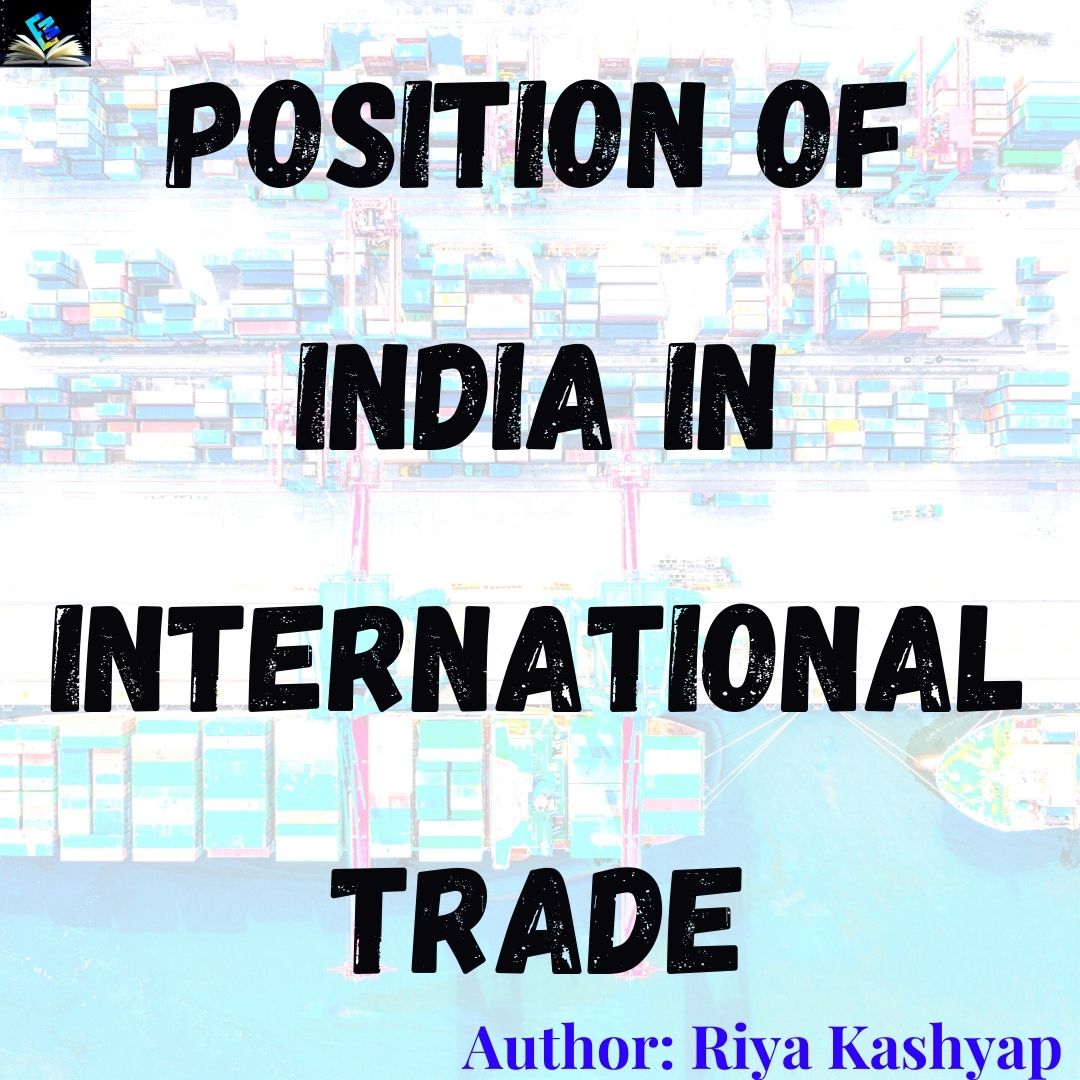
Position of India in International Trade
Keywords- International, Trade, India
Author: Riya Kashyap
International trade plays a vital role in the Indian economy. As the country needs to import diverse products, international trade is extremely important to the country. India exports a vast number of products and also imports an equal number of other products. Although India has steadily opened up its economy, its tariffs continue to be high when compared with other countries, and its investment norms are still restrictive. This leads some to see India as a ‘rapid globalizer’ while others still see it as a ‘highly protectionist’ economy. Nonetheless, in recent years, the government’s stand on trade and investment policy has displayed a marked shift from protecting producers to benefiting consumers. India is now aggressively pushing for a more liberal global trade regime, especially in services.
Global Trade was growing at 5.7 percent in 2017. However, in 2019-20, it is estimated to grow only at 1.0 percent.
Top Export Items
Petroleum products, precious stones, drug formulations & biologicals, gold and other precious metals are the top export commodities. India’s merchandise exports are less than its merchandise imports. Still, India’s merchandise trade balance has improved from 2009-14 to 2014-19. Although most of the improvement in the latter period was on account of more than 50% decline in crude prices in 2016-17.
Top Import Items
Crude petroleum, gold, petroleum products, coal, coke & briquettes constitute top import items. India’s service exports are more than its service imports. This means that India has a net service surplus. However, India’s net services surplus has been steadily declining in relation to GDP.
Export of Services
The composition of service exports has remained largely unchanged over the years. Software services constitute the bulk of it at around 40-45 percent; followed by business services at about 18-20 percent; travel at 11-14 per cent and transportation at 9-11 per cent. Over the years, service imports in relation to GDP have been steadily rising putting pressure on Bop to worsen. However, the increase in service imports to GDP ratio is inevitable given a rising level of FDI and a gradual upscaling of the Make in India program. Business Services, Travel, and Transportation are the three top service imports.
As per the WTO data released in April 2019, for the year 2018, India’s share in global exports for merchandise was 1.7 % and in global imports was 2.6 %. For the year 2018 for the service sector, India’s share in global exports was 3.5 % and imports were 3.2 %.
Steps to Boost Exports
The government of India is proactively taking several steps to boost exports, which inter-alia includes the following:
- The merger of Council of Trade and Development and Board of Trade provides a common platform for addressing stakeholder concerns:
- This common platform, comprising of representatives from industry, export promotion councils, Government of India and state governments and representatives from the banking and finance sector is playing a critical role in addressing export-related concerns, with a focus on addressing these on a priority basis.
- Infusion of funds for Export Support:
- A capital of Rs. 389 crores have been infused into Export Credit Guarantee Corporation (ECGC) on 21st June 2019. A Grant-in-aid (corpus) of Rs. 300 crores have been contributed to National Export Insurance Account (NEIA) trust on 21st June 2019, thereby enhancing its risk-taking capacity to support project exports in challenging markets.
- Agriculture Export Policy:
- A new Agriculture Export Policy (AEP) was approved in December 2018. To increase agriculture exports from the present US$ 30 Billion to US$ 60+ Billion by 2022. The outlay of Rs. 206 Crores for 2019-20 has been approved for its implementation.
- Boost to Gem and Jewellery exporters:
- Resolution of various issues which inter alia includes removal of the requirement of paying IGST on re-import of goods. Which were exported earlier for exhibition purpose/consignment basis. Allowing partial discharge of bonds executed by nominated agencies/banks for the import of gold to be supplied to jewellery exporters, thereby enabling nominated agencies/banks to release bank guarantees of jewellery exporters who have fulfilled their export obligation.
- Promoting Ease of Doing Business:
- Common Digital Platform for Issuance of electronic Certificates of Origin (Coo) for the exporters was launched on 16.09.2019 to improve ease of doing business for exporters.
- Special Economic Zone (Amendment) Bill, 2019
- SEZ (Amendment) Bill 2019 became the first legislation of the newly formed Government to be passed by the Parliament. It will enable any entity to set up a unit in SEZs, including Trusts. This would help boost investments and create new export and job opportunities.
- Better facilities for employees: SEZ units are allowed to create facilities/amenities like crèche, gymnasium, cafeteria, etc. for their exclusive use as a measure towards ease of doing business.
In June 2021, the merchandise exports increased to US$ 32.50 billion, registering an increase of ~ 48.34 % YoY and indicating a broad recovery in the trade driven by a strong performance of small businesses. With the upcoming trade policy 2021-26, the government plans to increase merchandise exports with emphasis on the higher share of MSME. Foreign trade policy 2021-26 is expected to focus on MSMEs and new export potential.
In March 2021, the central government announced plans to establish a new mechanism to increase import screening in order to protect domestic manufacturers. Details of the new screening process would be available in the foreign trade policy 2021-26, which is expected to commence next month. The available data would help domestic manufacturers analyse the market potential of such goods. The foreign trade policy 2021-26 is also expected to boost MSMEs and e-commerce exports. It will also identify new sectors to boost domestic export. On December 2, 2020, a meeting of the Board of Trade (BOT) was held under the chairmanship of Mr. Piyush Goyal. The focus of the meeting was on the new Foreign Trade Policy (2021-26). Outlining policies and steps to drive domestic production and exports.
Government reforms and inherent economic strengths have contributed to its standing as one of the most sought-after destinations for foreign investments in the world. Also, technological, and infrastructural development being carried out across the country augurs well for the trade and economic sector in the years to come. The Government of India has been working on striking important deals with the Governments of Japan, Australia, and China. To increase contribution towards the economic development of the country and growth in the global market.
India has the potential to increase its goods and services exports to Australia to:-
US$ 15 billion by 2025 and US$ 35 billion by 2035.
Mail us at edumoundofficial@gmail.com






